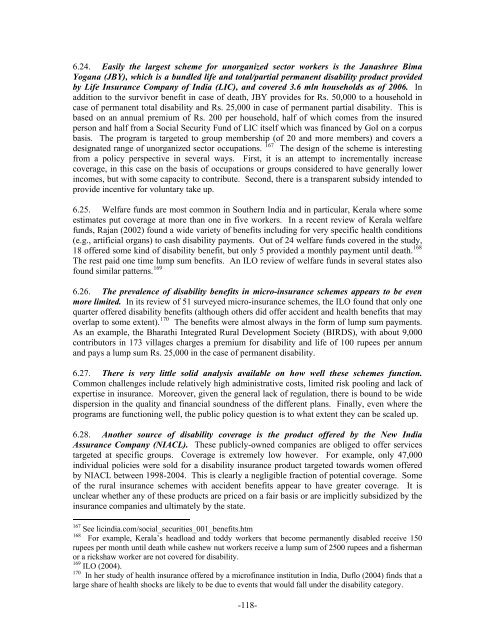People with Disabilities in India: From Commitment to Outcomes
People with Disabilities in India: From Commitment to Outcomes
People with Disabilities in India: From Commitment to Outcomes
You also want an ePaper? Increase the reach of your titles
YUMPU automatically turns print PDFs into web optimized ePapers that Google loves.
6.24. Easily the largest scheme for unorganized sec<strong>to</strong>r workers is the Janashree Bima<br />
Yogana (JBY), which is a bundled life and <strong>to</strong>tal/partial permanent disability product provided<br />
by Life Insurance Company of <strong>India</strong> (LIC), and covered 3.6 mln households as of 2006. In<br />
addition <strong>to</strong> the survivor benefit <strong>in</strong> case of death, JBY provides for Rs. 50,000 <strong>to</strong> a household <strong>in</strong><br />
case of permanent <strong>to</strong>tal disability and Rs. 25,000 <strong>in</strong> case of permanent partial disability. This is<br />
based on an annual premium of Rs. 200 per household, half of which comes from the <strong>in</strong>sured<br />
person and half from a Social Security Fund of LIC itself which was f<strong>in</strong>anced by GoI on a corpus<br />
basis. The program is targeted <strong>to</strong> group membership (of 20 and more members) and covers a<br />
designated range of unorganized sec<strong>to</strong>r occupations. 167 The design of the scheme is <strong>in</strong>terest<strong>in</strong>g<br />
from a policy perspective <strong>in</strong> several ways. First, it is an attempt <strong>to</strong> <strong>in</strong>crementally <strong>in</strong>crease<br />
coverage, <strong>in</strong> this case on the basis of occupations or groups considered <strong>to</strong> have generally lower<br />
<strong>in</strong>comes, but <strong>with</strong> some capacity <strong>to</strong> contribute. Second, there is a transparent subsidy <strong>in</strong>tended <strong>to</strong><br />
provide <strong>in</strong>centive for voluntary take up.<br />
6.25. Welfare funds are most common <strong>in</strong> Southern <strong>India</strong> and <strong>in</strong> particular, Kerala where some<br />
estimates put coverage at more than one <strong>in</strong> five workers. In a recent review of Kerala welfare<br />
funds, Rajan (2002) found a wide variety of benefits <strong>in</strong>clud<strong>in</strong>g for very specific health conditions<br />
(e.g., artificial organs) <strong>to</strong> cash disability payments. Out of 24 welfare funds covered <strong>in</strong> the study,<br />
18 offered some k<strong>in</strong>d of disability benefit, but only 5 provided a monthly payment until death. 168<br />
The rest paid one time lump sum benefits. An ILO review of welfare funds <strong>in</strong> several states also<br />
found similar patterns. 169<br />
6.26. The prevalence of disability benefits <strong>in</strong> micro-<strong>in</strong>surance schemes appears <strong>to</strong> be even<br />
more limited. In its review of 51 surveyed micro-<strong>in</strong>surance schemes, the ILO found that only one<br />
quarter offered disability benefits (although others did offer accident and health benefits that may<br />
overlap <strong>to</strong> some extent). 170 The benefits were almost always <strong>in</strong> the form of lump sum payments.<br />
As an example, the Bharathi Integrated Rural Development Society (BIRDS), <strong>with</strong> about 9,000<br />
contribu<strong>to</strong>rs <strong>in</strong> 173 villages charges a premium for disability and life of 100 rupees per annum<br />
and pays a lump sum Rs. 25,000 <strong>in</strong> the case of permanent disability.<br />
6.27. There is very little solid analysis available on how well these schemes function.<br />
Common challenges <strong>in</strong>clude relatively high adm<strong>in</strong>istrative costs, limited risk pool<strong>in</strong>g and lack of<br />
expertise <strong>in</strong> <strong>in</strong>surance. Moreover, given the general lack of regulation, there is bound <strong>to</strong> be wide<br />
dispersion <strong>in</strong> the quality and f<strong>in</strong>ancial soundness of the different plans. F<strong>in</strong>ally, even where the<br />
programs are function<strong>in</strong>g well, the public policy question is <strong>to</strong> what extent they can be scaled up.<br />
6.28. Another source of disability coverage is the product offered by the New <strong>India</strong><br />
Assurance Company (NIACL). These publicly-owned companies are obliged <strong>to</strong> offer services<br />
targeted at specific groups. Coverage is extremely low however. For example, only 47,000<br />
<strong>in</strong>dividual policies were sold for a disability <strong>in</strong>surance product targeted <strong>to</strong>wards women offered<br />
by NIACL between 1998-2004. This is clearly a negligible fraction of potential coverage. Some<br />
of the rural <strong>in</strong>surance schemes <strong>with</strong> accident benefits appear <strong>to</strong> have greater coverage. It is<br />
unclear whether any of these products are priced on a fair basis or are implicitly subsidized by the<br />
<strong>in</strong>surance companies and ultimately by the state.<br />
167 See lic<strong>in</strong>dia.com/social_securities_001_benefits.htm<br />
168<br />
For example, Kerala’s headload and <strong>to</strong>ddy workers that become permanently disabled receive 150<br />
rupees per month until death while cashew nut workers receive a lump sum of 2500 rupees and a fisherman<br />
or a rickshaw worker are not covered for disability.<br />
169 ILO (2004).<br />
170 In her study of health <strong>in</strong>surance offered by a microf<strong>in</strong>ance <strong>in</strong>stitution <strong>in</strong> <strong>India</strong>, Duflo (2004) f<strong>in</strong>ds that a<br />
large share of health shocks are likely <strong>to</strong> be due <strong>to</strong> events that would fall under the disability category.<br />
-118-










